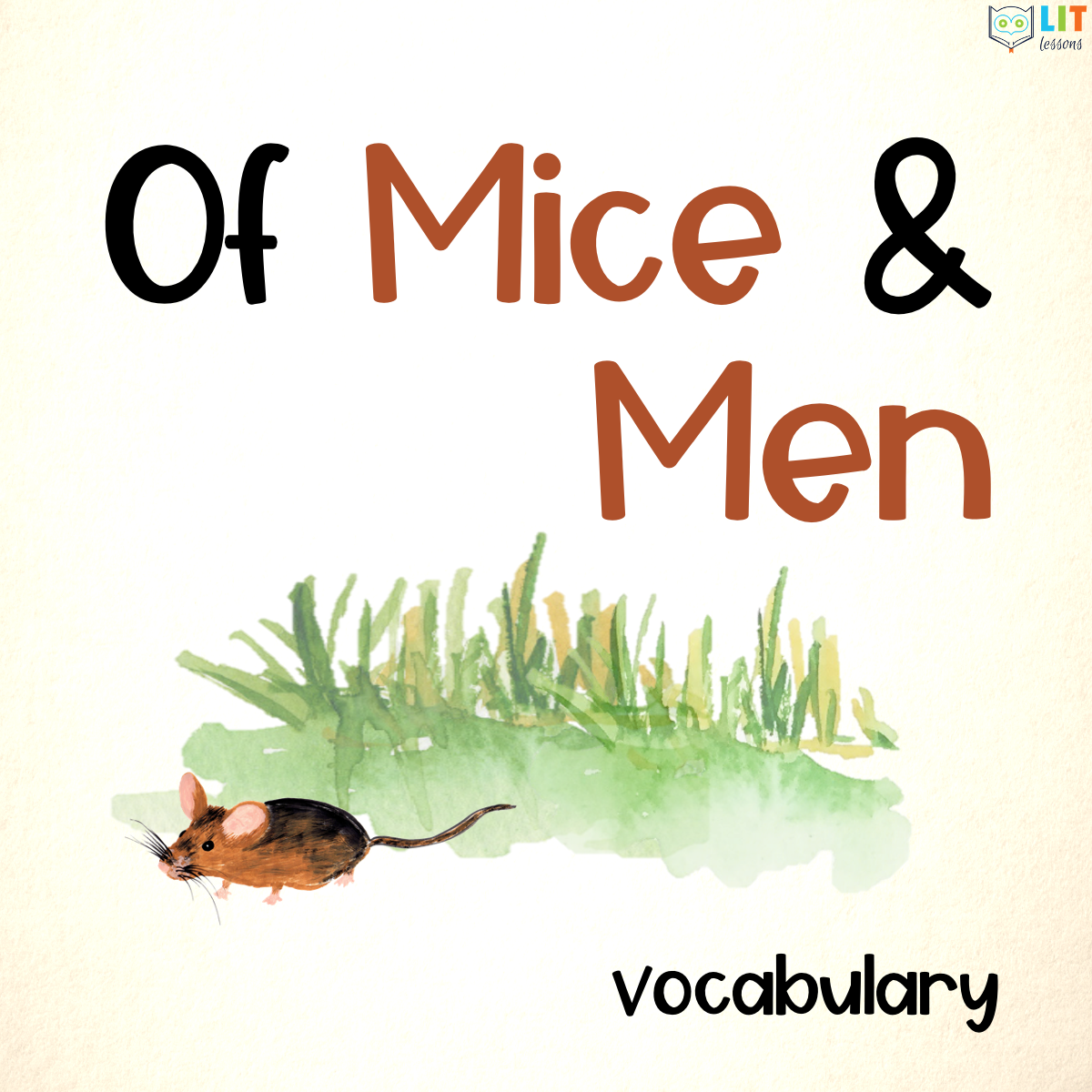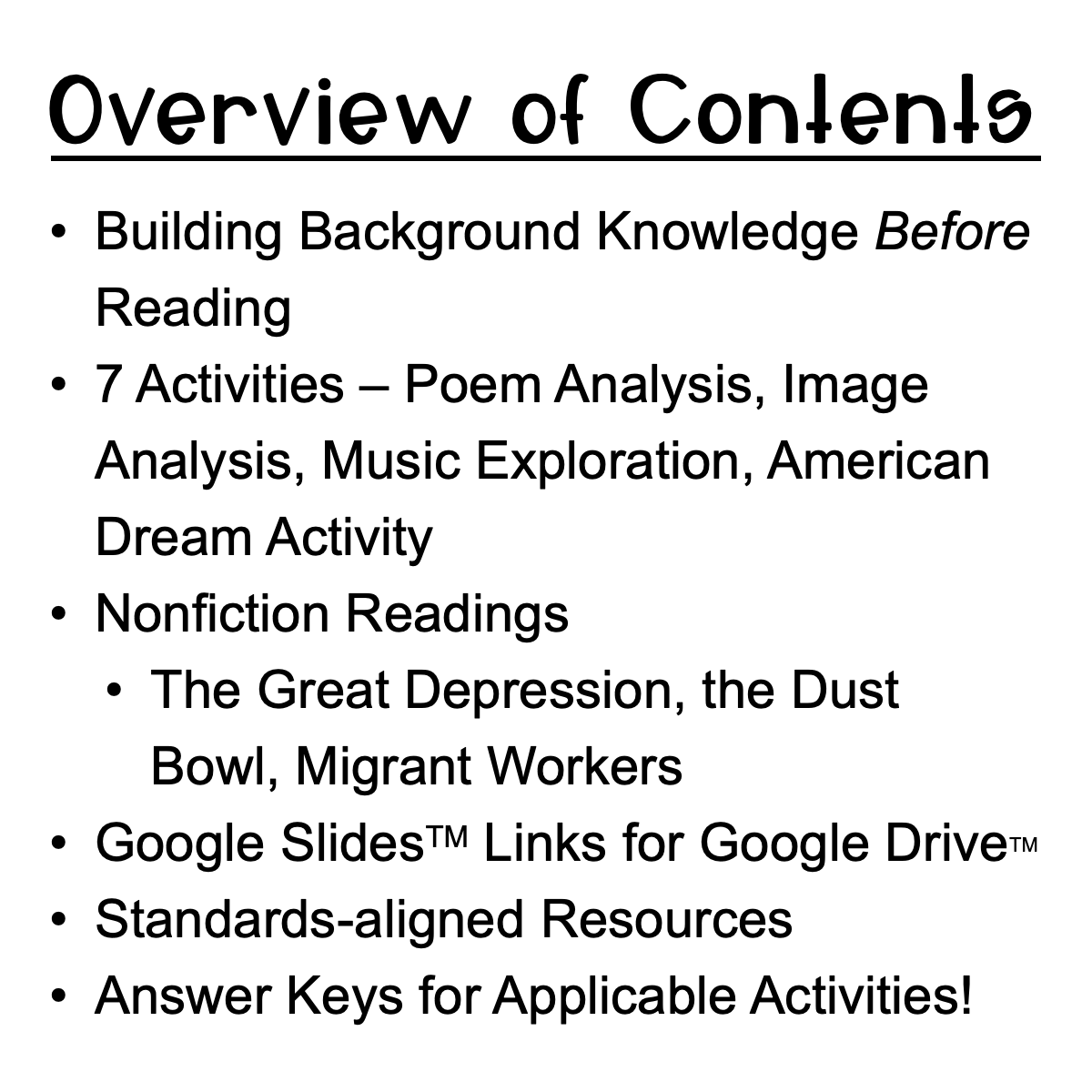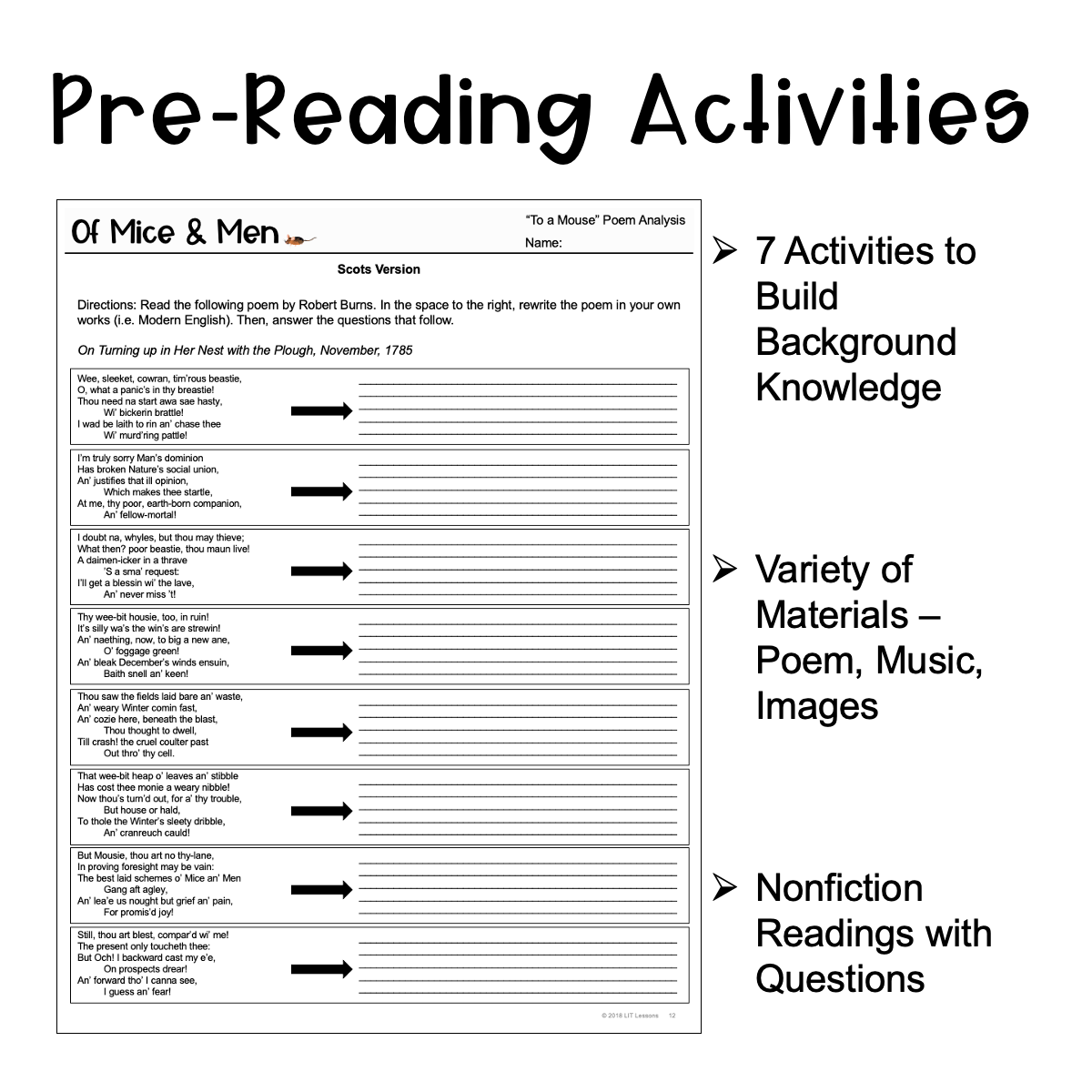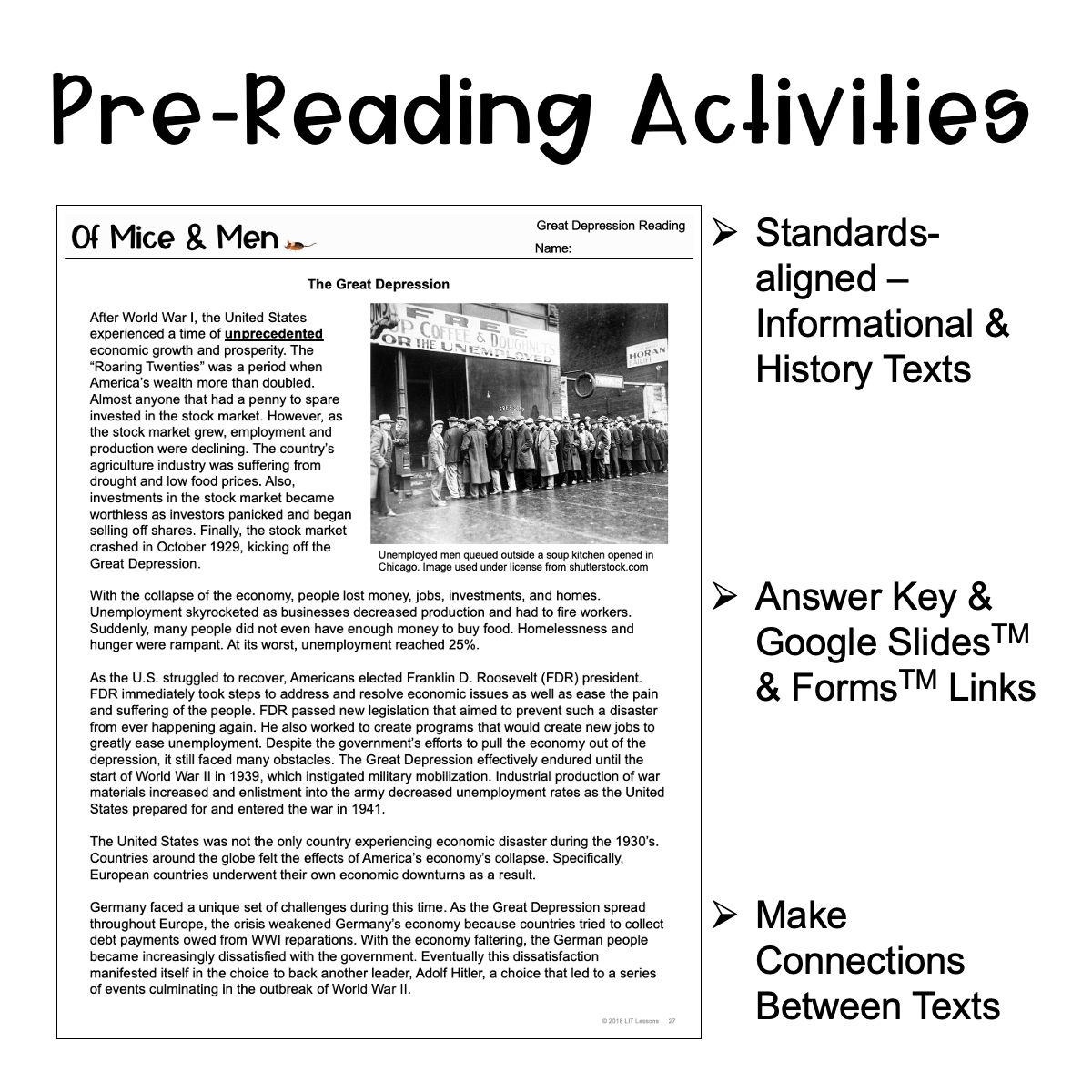Of Mice and Men Pre-Reading Resources
You can only add to a wishlist if you have an account, please register now.
Create an Account$5
Of Mice and Men Pre-Reading Resources – Snapshot of Included Resources:
- Building Background Knowledge Before Reading
- 7 Activities – Poem Analysis, Image Analysis, Music Exploration, American Dream Activity
- Nonfiction Readings
- The Great Depression, the Dust Bowl, Migrant Workers
- Google Slides™ Links for Google Drive™
- Standards-aligned Resources
- Answer Keys for Applicable Activities!
- Citing textual evidence to support analysis of the text.
- Summarizing the main idea of a text with supporting details.
- Determining the meaning of words or phrases as used in the text.
- Determine an author’s purpose in a text.
- ZIP file (PDFs and Word Docs for Digital Links)
- Non-Editable
- 15.53 MB
- 61 Pages
- Links for Student Pages in Google Slides™ & Google Forms™
- This downloadable resource supplies one single-teacher license for use in your classroom.
- Photocopying of this product is allowed only for the classroom use of the purchaser.
- Replication of this product, in whole or in part, for commercial sale or broader distribution is strictly prohibited.
- This product also may NOT be shared electronically, digitally, or otherwise in a manner that violates the Terms of Use detailed by LIT Lessons.
- For explicit information on permissions, please see the Terms of Use document included with this resource. Thank you for your cooperation and understanding.
Of Mice and Men Pre-Reading Resources – Snapshot of Included Resources:
- Building Background Knowledge Before Reading
- 7 Activities – Poem Analysis, Image Analysis, Music Exploration, American Dream Activity
- Nonfiction Readings
- The Great Depression, the Dust Bowl, Migrant Workers
- Google Slides™ Links for Google Drive™
- Standards-aligned Resources
- Answer Keys for Applicable Activities!
- Citing textual evidence to support analysis of the text.
- Summarizing the main idea of a text with supporting details.
- Determining the meaning of words or phrases as used in the text.
- Determine an author’s purpose in a text.
- ZIP file (PDFs and Word Docs for Digital Links)
- Non-Editable
- 15.53 MB
- 61 Pages
- Links for Student Pages in Google Slides™ & Google Forms™
- This downloadable resource supplies one single-teacher license for use in your classroom.
- Photocopying of this product is allowed only for the classroom use of the purchaser.
- Replication of this product, in whole or in part, for commercial sale or broader distribution is strictly prohibited.
- This product also may NOT be shared electronically, digitally, or otherwise in a manner that violates the Terms of Use detailed by LIT Lessons.
- For explicit information on permissions, please see the Terms of Use document included with this resource. Thank you for your cooperation and understanding.



More Of Mice and Men Resources...
Of Mice and Men Novel Study
The Of Mice and Men Novel Study is a comprehensive set of standards-aligned instructional materials for teaching Of Mice and Men by John Steinbeck. With over 70+ materials, students will deeply engage with the novel and develop their literacy skills. The close reading activities, literary analysis resources, pre-reading activities, vocabulary, and assessments all provide opportunities for your students to practice and apply what will be their growing understanding of the novel. They also provide numerous ways for you to DIFFERENTIATE learning for your students, allowing you to choose the assignments that best support your students’ learning while being conducive to any classroom model.
Of Mice and Men Chapter Questions
The 12 comprehension and literary analysis resources for John Steinbeck’s Of Mice and Men will give students repeated opportunities to practice essential literacy skills aligned to the Common Core State Standards. For every chapter, students will have to answer rigorous, text-based questions that assess not only their ability to comprehend but also their ability to analyze key events. With numerous options for implementation, the resource also allows for differentiation and can enable accommodation that will meet the needs of all learners. There are two sets of questions for each reading: Reading Response A (comprehension) and Reading Response B (analysis). The twin sets offer different levels of challenge for students to give you options for meeting the needs of all your learners.
Of Mice and Men Close Readings
The 6 close reading lessons explicitly focus on critical Common Core State Standards to develop students’ literacy proficiency. Using Of Mice and Men as the foundational text for close reading, each lesson focuses on a particular skill, such as setting, conflict, tone, and plot, and provides students an opportunity to develop and demonstrate their ability to perform that skill. The 6 argumentative writing exercises and resources will develop your students’ ability to make a claim, support that claim with evidence, and acknowledge opposing views. For each chapter, a debatable situation is presented. Students weigh which side they want to argue and then write an essay to support their view. A checklist of argumentative writing elements will help guide them along the way. The resources could supply homework, facilitate guided reading groups, or stimulate whole class literacy discussions for each chapter grouping. You can choose the purpose that best suits your students and your classroom.
Of Mice and Men Assessments
The standards-aligned assessments will help you measure your students’ comprehension of Of Mice and Men and their ability to apply the literary skills taught throughout the unit. The materials include 6 reading checks, 2 novel quizzes, 1 final assessment, and essay choice board.
Of Mice and Men Vocabulary
The vocabulary resources will engage students in varied activities to expand their vocabulary. The resources include materials to help teach challenging vocabulary words in Of Mice and Men that will then build your students’ vocabulary. With 6 vocabulary lists of 10 words each and a crossword puzzle, practice assignment, and quiz for each set, the materials provide opportunities for differentiation to suit the needs of the classroom.

Of Mice and Men Novel Study
The Of Mice and Men Novel Study is a comprehensive set of standards-aligned instructional materials for teaching Of Mice and Men by John Steinbeck. With over 70+ materials, students will deeply engage with the novel and develop their literacy skills. The close reading activities, literary analysis resources, pre-reading activities, vocabulary, and assessments all provide opportunities for your students to practice and apply what will be their growing understanding of the novel. They also provide numerous ways for you to DIFFERENTIATE learning for your students, allowing you to choose the assignments that best support your students’ learning while being conducive to any classroom model.

Of Mice and Men Chapter Questions
The 12 comprehension and literary analysis resources for John Steinbeck’s Of Mice and Men will give students repeated opportunities to practice essential literacy skills aligned to the Common Core State Standards. For every chapter, students will have to answer rigorous, text-based questions that assess not only their ability to comprehend but also their ability to analyze key events. With numerous options for implementation, the resource also allows for differentiation and can enable accommodation that will meet the needs of all learners. There are two sets of questions for each reading: Reading Response A (comprehension) and Reading Response B (analysis). The twin sets offer different levels of challenge for students to give you options for meeting the needs of all your learners.

Of Mice and Men Close Readings
The 6 close reading lessons explicitly focus on critical Common Core State Standards to develop students’ literacy proficiency. Using Of Mice and Men as the foundational text for close reading, each lesson focuses on a particular skill, such as setting, conflict, tone, and plot, and provides students an opportunity to develop and demonstrate their ability to perform that skill. The 6 argumentative writing exercises and resources will develop your students’ ability to make a claim, support that claim with evidence, and acknowledge opposing views. For each chapter, a debatable situation is presented. Students weigh which side they want to argue and then write an essay to support their view. A checklist of argumentative writing elements will help guide them along the way. The resources could supply homework, facilitate guided reading groups, or stimulate whole class literacy discussions for each chapter grouping. You can choose the purpose that best suits your students and your classroom.

Of Mice and Men Assessments
The standards-aligned assessments will help you measure your students’ comprehension of Of Mice and Men and their ability to apply the literary skills taught throughout the unit. The materials include 6 reading checks, 2 novel quizzes, 1 final assessment, and essay choice board.

Of Mice and Men Vocabulary
The vocabulary resources will engage students in varied activities to expand their vocabulary. The resources include materials to help teach challenging vocabulary words in Of Mice and Men that will then build your students’ vocabulary. With 6 vocabulary lists of 10 words each and a crossword puzzle, practice assignment, and quiz for each set, the materials provide opportunities for differentiation to suit the needs of the classroom.








